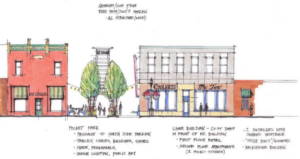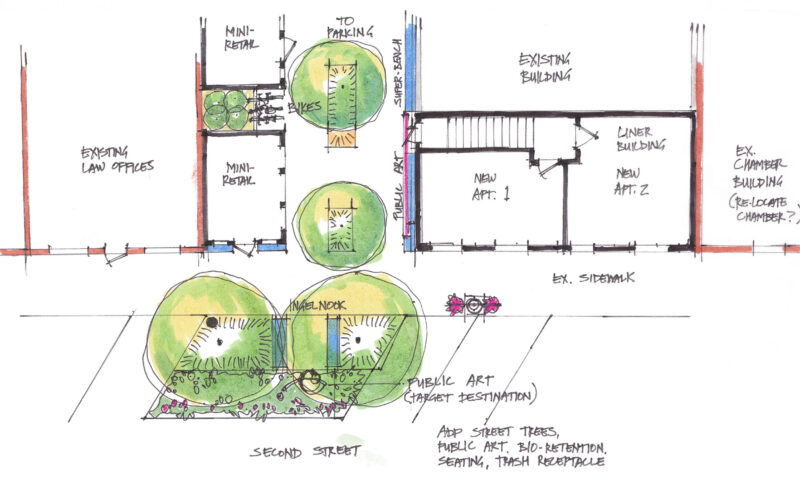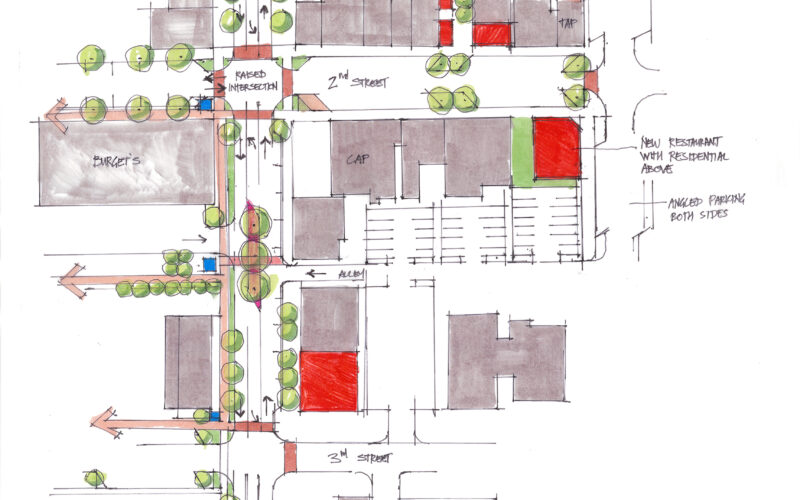The Altoona Area Historical Society is proud to work with the Altoona Area Chamber of Commerce and the City of Altoona to start the process of evaluating a potential revitalization of Olde Town Altoona. The Altoona Area Historical Society has a representative sitting on the Altoona Area Chamber of Commerce’s Olde Town Revitalization Task Force. Below is part of the summary assessment from the Iowa Economic Development Authority’s Downtown Resource Center. You can also find the action steps that the Altoona Area Historical Society is working on as a part of the revitalization effort. You can find the full report here, and watch the presentation here.
DOWNTOWN ASSESSMENT SUMMARY
During the Summer of 2020, the Iowa Economic Development Authority’s Downtown Resource Center conducted an assessment of Olde Town Altoona. The assessment will help to raise awareness of the area, provide education, make recommendations, and encourage the local community in their revitalization efforts. This summary provides an overview of recommendations made by the Iowa Downtown Resource Center team following their assessment of Olde Town Altoona conducted on August 25-27, 2020. The following is a summary report of the assessment from IEDA.
SURVEY SAYS…
Prior to the Downtown Assessment, the Iowa Downtown Resource Center administered an online survey to residents of Altoona to get their ideas and opinions about the Olde Town area. The survey was distributed primarily through social media channels initiated by the Chamber of Commerce, shared by partnering individuals and entities, and was distributed to the Chamber’s email list.

IN ADDITION to the pre-visit survey, the assessment included a review of prior planning materials, driving and walking tours of the Olde Town district and surrounding areas, and interviews with community leaders, individuals representing the public and private sector stakeholder groups, and community members. Based on these activities and the Assessment Team’s extensive working knowledge in downtown economic development, recommendations for Olde Town improvement efforts were grouped into the following six themes.
CONTEXT & GATEWAYS
 A unique strength of Altoona is the number of large, regional destinations that draw a tremendous number of visitors to the area for entertainment and shopping. Although Olde Town is located within a 2-mile radius of these highly visited attractions – it seems a world away. Olde Town has the potential to serve as an alternate destination for residents and visitors alike due to its small-town character, walkability, and welcoming atmosphere. Currently, the Olde Town district lacks clear boundaries, signage, and identity. Expand the boundaries beyond the core intersection of 1st Avenue and 2nd Street. Consider gateway features at key points along 1st Avenue to better define the district and projects a clear sense of arrival. Gateways should tie into the unique character and history of Altoona and set the tone for the look and feel of the district.
A unique strength of Altoona is the number of large, regional destinations that draw a tremendous number of visitors to the area for entertainment and shopping. Although Olde Town is located within a 2-mile radius of these highly visited attractions – it seems a world away. Olde Town has the potential to serve as an alternate destination for residents and visitors alike due to its small-town character, walkability, and welcoming atmosphere. Currently, the Olde Town district lacks clear boundaries, signage, and identity. Expand the boundaries beyond the core intersection of 1st Avenue and 2nd Street. Consider gateway features at key points along 1st Avenue to better define the district and projects a clear sense of arrival. Gateways should tie into the unique character and history of Altoona and set the tone for the look and feel of the district.
OLDE TOWN EXPERIENCE
Think about Olde Town as an EXPERIENCE. Successful places are engaging, memorable, and activate as many of the five senses as possible. Both small and large details “can and must work together” to create these unique experiences in downtown districts.
• If you want people to come to Olde Town, they need to know what is available and how to get there. Add directional signage at key intersections off Interstate 80, incorporate wayfinding signage to connect with and capitalize upon the local bicycle trail network, and enhance local business signage by projecting signs to increase businesses’ visibility and add color and dimension to the streetscape.
• Consider amenities that add function and comfort to the street while enhancing the look and feel of the district. Add banners and greenery to the existing light poles, install seating opportunities throughout the district, and provide convenience items like trash cans and bike racks.
• Rethink the streets. Actively engage in the City’s proposed 1st Avenue reconstruction plans and consider ways to reconfigure 2nd Street to support more flexibility and uses. Low-cost, temporary projects can explore configurations that improve pedestrian and bicycling safety and transform areas of the street for community gathering spaces, seating areas, or outdoor dining.
• Integrate storytelling and art into Olde Town. Partner with the Arts & Culture Committee to incorporate art and engagement strategies that help tell the stories of Olde Town’s past and support the creation of future stories.
BUILT ENVIRONMENT
 The architectural character of Olde Town was identified as one of its strengths through the community survey process. Maintaining and complementing this character will be important as revitalization efforts continue. With its low vacancy rate and lack of available building space – new infill construction or adaptive reuse will most likely be necessary to accommodate district growth. Consider design guidelines to ensure this development is appropriate for the character and scale of Olde Town and link any funding assistance to compliance with the guidelines. Consider modifications to existing infill buildings that enhance the street-facing facade and provide added usable floor space. Selective redevelopment of dilapidated building sites along 2nd Street can provide an added amenity with green space, a pedestrian passageway to parking, and opportunities for public art and gathering space.
The architectural character of Olde Town was identified as one of its strengths through the community survey process. Maintaining and complementing this character will be important as revitalization efforts continue. With its low vacancy rate and lack of available building space – new infill construction or adaptive reuse will most likely be necessary to accommodate district growth. Consider design guidelines to ensure this development is appropriate for the character and scale of Olde Town and link any funding assistance to compliance with the guidelines. Consider modifications to existing infill buildings that enhance the street-facing facade and provide added usable floor space. Selective redevelopment of dilapidated building sites along 2nd Street can provide an added amenity with green space, a pedestrian passageway to parking, and opportunities for public art and gathering space.
ECONOMIC DEVELOPMENT – INCENTIVES & EXPANSION
 Create an environment “to succeed” by helping businesses thrive within the Olde Town district. This includes efforts to understand existing market conditions, retention, and expansion of existing businesses, and finally – recruitment and development. A key ingredient to creating places that are engaging with multiple venues and things to do is a mix of tenants within the buildings and spaces in that place. Diversifying the tenant mix of Olde Town must be a top priority for the area. To accommodate desired business growth and tenant mix, actions will be needed to create new spaces for both existing and targeted new businesses. Some changes to the tenant mix could take place quickly with assistance from the city and current building and business owners through space realignment, while other opportunities like pop-up shops and infill development will be longer-term solutions. Create “targeted incentives” for the “kind of development” you want to see.
Create an environment “to succeed” by helping businesses thrive within the Olde Town district. This includes efforts to understand existing market conditions, retention, and expansion of existing businesses, and finally – recruitment and development. A key ingredient to creating places that are engaging with multiple venues and things to do is a mix of tenants within the buildings and spaces in that place. Diversifying the tenant mix of Olde Town must be a top priority for the area. To accommodate desired business growth and tenant mix, actions will be needed to create new spaces for both existing and targeted new businesses. Some changes to the tenant mix could take place quickly with assistance from the city and current building and business owners through space realignment, while other opportunities like pop-up shops and infill development will be longer-term solutions. Create “targeted incentives” for the “kind of development” you want to see.
EVENTS & ACTIVITIES
The staging of promotional events is an essential ingredient to every community’s downtown development success. Events serve as catalysts to bring people together and they create energy. It’s vital that Olde Town is programmed with promotional events and activities that increase awareness of the district, establish Olde Town as a center for activity and community life, and showcase current businesses and future business opportunities.
• The Farmer’s Market was mentioned in the survey and nearly every group interviewed. Reinstating the Market in Olde Town will help draw weekly traffic to the district on a regular basis.
• Build on the success of the existing Christmas in Olde Town event. Review the schedule and add a variety of activities that appeal to different audiences. Consider expanding the programming to last throughout the weekend.
• When considering new events, be INTENTIONAL when determining the activities, you implement. Be authentic, speak to your target audience and build on Olde Town’s unique assets. Projecting a movie onto the grain elevators for a “drive-in” movie night activity would be a logical tie that expands the use of existing assets.
TAKING ACTION
The revitalization of Olde Town Altoona will be an incremental process. Although many large-scale projects will require considerable time and investment – small steps must be taken now to set the stage for success. Define the vision for Olde Town – one that creates buy-in from the community at large, engages partnerships, and maintains the locally-led momentum going forward. Designate the resources – both human and financial – to move forward. Communicate the vision – broadly and often. Provide regular updates on progress and events to the community at large – with a special focus on existing district buildings and business owners – to help foster connection and engagement. Identify and act on small-scale projects that can provide initial wins and momentum for the district. Small building improvement projects like awnings and signs, or simple street amenity enhancements (banners, flowers, benches) are relatively low-cost, high-impact improvements that provide good visibility for the district.
HISTORICAL SOCIETY ACTION STEPS
The Altoona Area Historical Society is taking this time to look at the future of our organization, and how we can be an active part in the revitalization efforts in Olde Town. The Altoona Area Historical Society board has launched the Altoona 2030 project, to set goals and projects for the future of the organization. With the revitalization efforts underway, it is the perfect time to look at the programming we offer, how our museum fits into the vision, and what other opportunities we can provide. Below are the action steps being considered.
- Potential museum expansion opportunities
- Renovation of the current building
- Addition of retail and/or coffee shop to the museum
- New events
- New partnerships with local businesses and organizations
- Increased public outreach opportunities
- New/expanded programming
If you would like to be a part of Altoona 2030 or have any ideas, please email us at altoonahistory@gmail.com.






